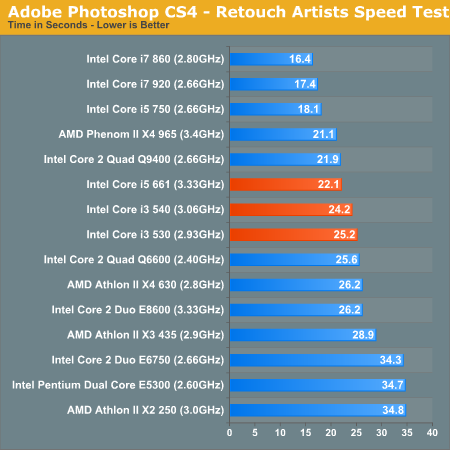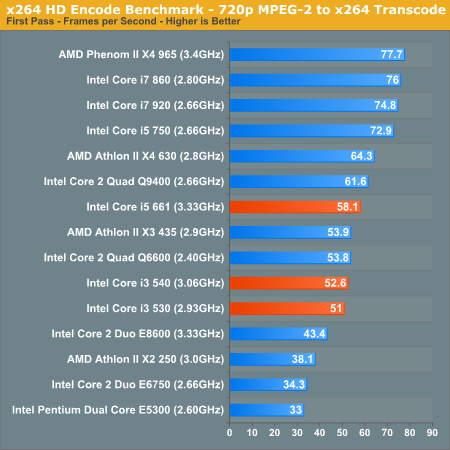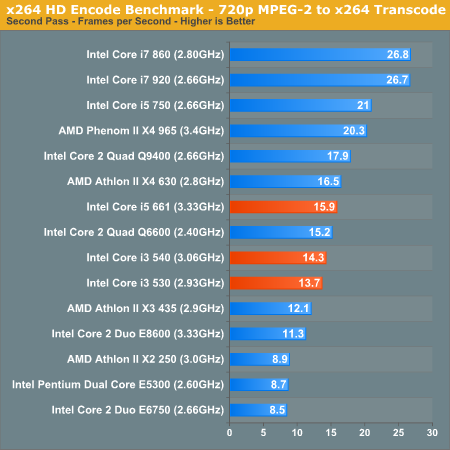The Clarkdale Review: Intel's Core i5 661, i3 540 & i3 530
by Anand Lal Shimpi on January 4, 2010 12:00 AM EST- Posted in
- CPUs
Adobe Photoshop CS4 Performance
To measure performance under Photoshop CS4 we turn to the Retouch Artists’ Speed Test. The test does basic photo editing; there are a couple of color space conversions, many layer creations, color curve adjustment, image and canvas size adjustment, unsharp mask, and finally a gaussian blur performed on the entire image.
The whole process is timed and thanks to the use of Intel's X25-M SSD as our test bed hard drive, performance is far more predictable than back when we used to test on mechanical disks.
Time is reported in seconds and the lower numbers mean better performance. The test is multithreaded and can hit all four cores in a quad-core machine.

And this is where everything changes. While our Photoshop test won't keep four cores busy 100% of the time, it's enough to give the quad-core CPUs an advantage. Here the Core i5 661 is around the speed of a Q9400 but nowhere near the similarly priced Lynnfield Core i5 750.
The Core i3 540/530 are valuable as they are both able to outperform AMD's similarly priced Athlon II X4 630. The 661 doesn't make sense here but for the price, the i3 530/540 look promising.
DivX 8.5.3 with Xmpeg 5.0.3
Our DivX test is the same DivX / XMpeg 5.03 test we've run for the past few years now, the 1080p source file is encoded using the unconstrained DivX profile, quality/performance is set balanced at 5 and enhanced multithreading is enabled:

Video encoding is where you need more cores, and this is where the Core i5 661 really loses out in terms of value. It's the same price as a Core i5 750 but it's clearly slower. Turbo isn't saving the 661.
The Core i3 540 and 530 however look competitive. They're able to perform at around the same level as AMD's Athlon II X4 630, while drawing much less power.
x264 HD Video Encoding Performance
Graysky's x264 HD test uses the publicly available x264 encoder to encode a 4Mbps 720p MPEG-2 source. The focus here is on quality rather than speed, thus the benchmark uses a 2-pass encode and reports the average frame rate in each pass.

Competitive in DivX encoding, yes. But in our x264 encoding test, these Clarkdales just don't make sense. If you do a lot of x264 video encoding you're going to want Lynnfield or a quad-core Athlon II/Phenom II.

Windows Media Encoder 9 x64 Advanced Profile
In order to be codec agnostic we've got a Windows Media Encoder benchmark looking at the same sort of thing we've been doing in the DivX and x264 tests, but using WME instead.

Rounding out our video encoding tests Windows Media Encoder 9 doesn't really show us anything different. The Core i5 661 is slower than it should be given its price, and here even the i3s lose out. If you do a lot of encoding, you want four cores. Simple as that.










93 Comments
View All Comments
Taft12 - Monday, January 4, 2010 - link
The parent's office PC's aren't bottlenecked by the OS - they're not bottlenecked PERIOD. They run modern productivity apps just fine and would gain little to no benefit from Core i3 (or Windows 7 for that matter).Paulman - Monday, January 4, 2010 - link
Those office PC's you mentioned aren't bottlenecked by the 2GB of RAM. But I wouldn't say that they aren't bottlenecked, "period". What they ARE bottlenecked by is disk I/O, I'm sure. Throw in a good SSD and you would notice quite a bit of speed improvement, and probably a noticeable difference between the 1.6GHz and 2.4GHz machines.The most annoying thing to me whenever I'm using my PC is seeing and hearing my laptop HDD thrash around when launching an app or what not, because everything is held up as a result. Yes, I know it's a laptop HDD, but desktop drives are pretty slow, too.
FlyTexas - Monday, January 4, 2010 - link
SSDs are indeed fast, and make the whole computer feel "snappier"...However, these office machines never shut down (they hibernate overnight). IE8, Word, Excel, and Acrobat are always open and always stay open. Once loaded in memory, the hard drive is hardly used.
I've looked at upgrading them to 3GB of RAM, but they aren't using what they have, so why bother? Most of them use right around 1GB of RAM most of the time.
Could we put 40GB SSDs in? Sure, they are about $130 at Newegg right now... Not the end of the world, until you multiply that times 24 machines. Not a minor expense.
FlyTexas - Monday, January 4, 2010 - link
That is so true. This the first time in a long time that the computers have been "fast enough" for everything we use them for.There was a time in 1993/1994 that we were in this position, running DOS 6 and Windows 3.1 on 486DX2/66 machines, where the move to the DX4/100 or Pentium saw no benefit until Windows 95 came out. I worked in small shop back then, and we demoed a Pentium 66 machine, and saw zero benefit over the 486DX2/66 machines, other than it cost twice as much.
Perhaps in 2002, the Athlon XP machines were "fast enough" for Windows XP and Office XP, that was a nice time as well in the business. A Pentium III 550mhz was my last personal Intel chip until 2006, when I got my first Core2Duo machine at home. I had to work with some Pentium 4s at work during that time, Intel really, REALLY dropped the ball with the Pentium 4, IMHO.
Oh well... I've been doing this a long time, I still remember 5.25" floppy drives, with NO hard drive and those ugly green monitors with Hercules graphics... :)
lowlight - Monday, January 4, 2010 - link
But the 45nm package on Westmere doesn't just carry the GPU. They also moved the PCI-E controller and Memory controller there. I guess the "CPU" is still technically 32nm, but compared to Nehalem, half the "CPU" actually resides on a 45nm package on the chip...You can see a diagram in this Clarkdale review: http://www.hardcoreware.net/intel-clarkdale-core-i...">http://www.hardcoreware.net/intel-clarkdale-core-i...
lowlight - Monday, January 4, 2010 - link
Guess I should have read the whole review... You guys picked it up too! Not many others did though ;)ilnot1 - Monday, January 4, 2010 - link
I swear I've scoured the pages but I don't see your Test System Setup Chart: how much RAM, which graphics card? If it is there and I missed it I wish you could delete posts.Spoelie - Monday, January 4, 2010 - link
It's on page 6I'd like to know the setup of each memory benchmark on page 2. What memory speeds and settings were used for the latency and bandwidth numbers?
Anand Lal Shimpi - Monday, January 4, 2010 - link
All of the CPUs used DDR3-1333 running at 7-7-7-20 timings for that test. I used Everest 1909 (I believe, I'm about 2300 miles away from my testbed right now :-P) and CPU-Z's latency tool to grab the data.Take care,
Anand
toyota - Monday, January 4, 2010 - link
I was looking for it too and its not there.